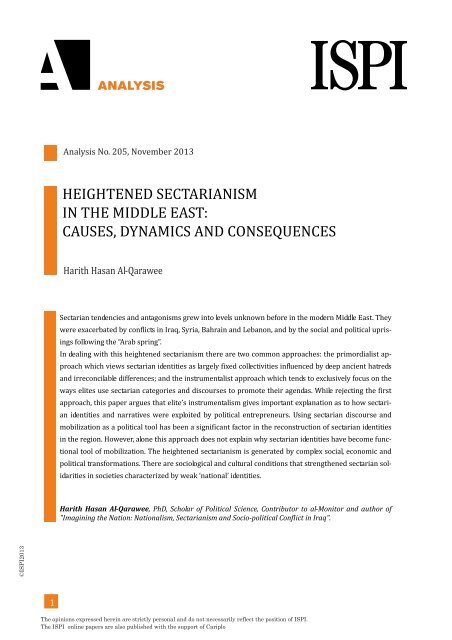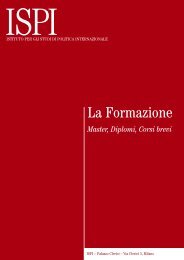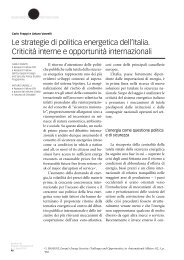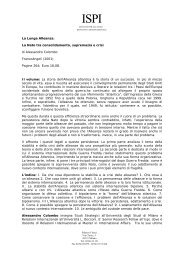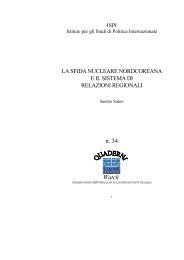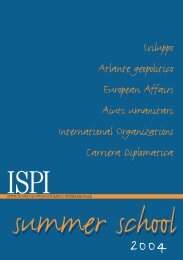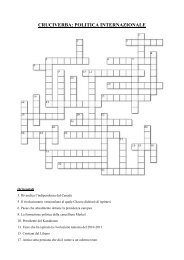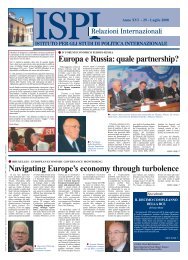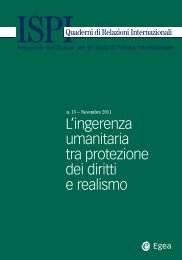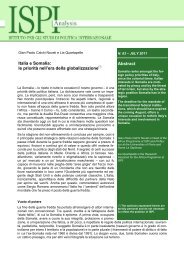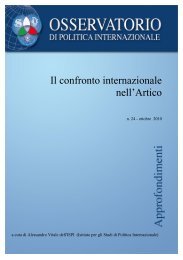heightened sectarianism in the middle east: causes, dynamics ... - Ispi
heightened sectarianism in the middle east: causes, dynamics ... - Ispi
heightened sectarianism in the middle east: causes, dynamics ... - Ispi
Create successful ePaper yourself
Turn your PDF publications into a flip-book with our unique Google optimized e-Paper software.
Analysis No. 205, November 2013HEIGHTENED SECTARIANISMIN THE MIDDLE EAST:CAUSES, DYNAMICS AND CONSEQUENCESHarith Hasan Al‐QaraweeSectarian tendencies and antagonisms grew <strong>in</strong>to levels unknown before <strong>in</strong> <strong>the</strong> modern Middle East. Theywere exacerbated by conflicts <strong>in</strong> Iraq, Syria, Bahra<strong>in</strong> and Lebanon, and by <strong>the</strong> social and political upris<strong>in</strong>gsfollow<strong>in</strong>g <strong>the</strong> “Arab spr<strong>in</strong>g”.In deal<strong>in</strong>g with this <strong>heightened</strong> <strong>sectarianism</strong> <strong>the</strong>re are two common approaches: <strong>the</strong> primordialist approachwhich views sectarian identities as largely fixed collectivities <strong>in</strong>fluenced by deep ancient hatredsand irreconcilable differences; and <strong>the</strong> <strong>in</strong>strumentalist approach which tends to exclusively focus on <strong>the</strong>ways elites use sectarian categories and discourses to promote <strong>the</strong>ir agendas. While reject<strong>in</strong>g <strong>the</strong> firstapproach, this paper argues that elite’s <strong>in</strong>strumentalism gives important explanation as to how sectarianidentities and narratives were exploited by political entrepreneurs. Us<strong>in</strong>g sectarian discourse andmobilization as a political tool has been a significant factor <strong>in</strong> <strong>the</strong> reconstruction of sectarian identities<strong>in</strong> <strong>the</strong> region. However, alone this approach does not expla<strong>in</strong> why sectarian identities have become functionaltool of mobilization. The <strong>heightened</strong> <strong>sectarianism</strong> is generated by complex social, economic andpolitical transformations. There are sociological and cultural conditions that streng<strong>the</strong>ned sectarian solidarities<strong>in</strong> societies characterized by weak ‘national’ identities.Harith Hasan Al‐Qarawee, PhD, Scholar of Political Science, Contributor to al‐Monitor and author of"Imag<strong>in</strong><strong>in</strong>g <strong>the</strong> Nation: Nationalism, Sectarianism and Socio‐political Conflict <strong>in</strong> Iraq".©ISPI20131The op<strong>in</strong>ions expressed here<strong>in</strong> are strictly personal and do not necessarily reflect <strong>the</strong> position of ISPI.The ISPI onl<strong>in</strong>e papers are also published with <strong>the</strong> support of Cariplo
IntroductionSectarian tendencies and antagonisms grew <strong>in</strong>to levels previouslyunknown <strong>in</strong> <strong>the</strong> modern Middle East. They were exacerbated byconflicts <strong>in</strong> Iraq, Syria, Bahra<strong>in</strong> and Lebanon, and by <strong>the</strong> socialand political upris<strong>in</strong>gs follow<strong>in</strong>g <strong>the</strong> Arab Spr<strong>in</strong>g. Some argue that<strong>the</strong> Sunni-Shi’a divide, <strong>in</strong> particular, is “on its way to displac<strong>in</strong>g<strong>the</strong> broader conflict between Muslims and <strong>the</strong> West as <strong>the</strong> primarychallenge fac<strong>in</strong>g <strong>the</strong> Islamic societies of <strong>the</strong> Middle East for <strong>the</strong>foreseeable future” 1 .The toppl<strong>in</strong>g of Saddam’s regime and <strong>the</strong> occupation of Iraq by USforces <strong>in</strong> 2003 <strong>in</strong>tensified sectarian conflict and resulted <strong>in</strong> extremeforms of <strong>in</strong>ter-communal violence. As a consequence, a processof identity construction that emphasizes <strong>the</strong> sectarian dividewith<strong>in</strong> Islam has fur<strong>the</strong>r evolved and its geopolitical implicationsbegun to be noticeable. This process ga<strong>in</strong>ed momentum after <strong>the</strong> upris<strong>in</strong>g<strong>in</strong> Syria <strong>in</strong> 2011 that led to a bloodshed that has <strong>the</strong> characteristicsof sectarian civil war. The Syrian war became a proxy war, <strong>in</strong>volv<strong>in</strong>gstates and non-state actors divided between predom<strong>in</strong>antly Sunni andpredom<strong>in</strong>antly Shi’a camps.This paper exam<strong>in</strong>es both <strong>the</strong> socio-cultural contexts of this <strong>heightened</strong><strong>sectarianism</strong> and its <strong>in</strong>strumental exploitation by political entrepreneurs.Follow<strong>in</strong>g <strong>the</strong> literature on ‘ethnicization’ 2 , I argue that ‘Sectarianization’is a process caused by complex social, economic and politicaltransformations. It cannot be simplified as a ‘revival’ of ancientreligious hatreds. There are sociological and cultural conditions thatstreng<strong>the</strong>ned sectarian solidarities <strong>in</strong> societies characterized by weak‘national’ identities. I also argue that us<strong>in</strong>g sectarian rhetoric and mobilizationas a political <strong>in</strong>strument has been a significant factor <strong>in</strong> <strong>the</strong>reconstruction of sectarian identities <strong>in</strong> <strong>the</strong> region.The post‐revolutionary‘Sectarianization’ is aprocess caused by complexsocial, economic andpolitical transformations.It cannot be simplified as a‘revival’ of ancientreligious hatreds. Thereare sociological andcultural conditions thatstreng<strong>the</strong>ned sectariansolidarities <strong>in</strong> societiescharacterized by weak‘national’ identities©ISPI20131G. ABDO, The New Sectarianism: <strong>the</strong> Arab Upris<strong>in</strong>g and <strong>the</strong> Rebirth of <strong>the</strong>Shi’a-Sunni Divide, Analysis paper P2, The Saban Center for Middle East Policy,Brook<strong>in</strong>gs, 2013.2Recent literature on identity politics and ethnic conflicts tend to reject primordialism,which takes ethnic and sectarian groups as ‘givens’ and conceives <strong>the</strong>mas de-contextualized ‘entities’. For example, <strong>the</strong> very concept of ‘group’ has beenquestioned by Brubaker who, <strong>in</strong>stead, preferred to analyze <strong>the</strong> ‘groupness’ ascognitive processes conditioned by external variables. Ra<strong>the</strong>r than <strong>the</strong> commonconcept of ethnicity, he suggested <strong>the</strong> concept of ethnicization (<strong>in</strong> my analogy, sectarianization)to reflect <strong>the</strong> dynamic nature of culture and identities. See R.BRUBAKER, Ethnicity Without Groups, Harvard, Harvard University Press,2004.; R. BRUBAKER, M. LOVEMAN, P. STAMATOV, Ethnicity as Cognition,«Theory and Society», vol.33, no. 1, 2004, pp. 31-64.2
Socio-Cultural Dynamics of Sectarianization‘Ancient conflict’ narratives are used by groups with sectarian ideologiesto create <strong>the</strong> sense of historical cont<strong>in</strong>uity and mission.However, today’s <strong>heightened</strong> <strong>sectarianism</strong>, I argue, is caused by<strong>the</strong> specific conditions of <strong>in</strong>complete modernization <strong>in</strong> <strong>the</strong> MiddleEast.Any attempt to address past events through <strong>the</strong> lenses of today’sconflicts leads to more misconceptions. For example, def<strong>in</strong><strong>in</strong>g SaddamHusse<strong>in</strong>’s regime <strong>in</strong> Iraq as ‘Sunni’ and Assad’s regime <strong>in</strong> Syriaas simply ‘Alawite’, is driven less by concrete facts and more bya reductionist approach that views everyth<strong>in</strong>g through <strong>the</strong> sectariannarrative. This is not to say that <strong>sectarianism</strong> has not beenan <strong>in</strong>fluential force. It was always <strong>the</strong>re, usually play<strong>in</strong>g a role <strong>in</strong>shap<strong>in</strong>g beh<strong>in</strong>d-<strong>the</strong>-scenes alliances and political lean<strong>in</strong>gs. Never<strong>the</strong>less,it was not <strong>the</strong> only force, nor an important one sometimes.It is difficult to imag<strong>in</strong>e a m<strong>in</strong>ority (e.g. Syrian Alawites or Iraqi Sunnis)rul<strong>in</strong>g a majority with<strong>in</strong> a context emphasiz<strong>in</strong>g <strong>the</strong>ir m<strong>in</strong>ority status:<strong>in</strong> this case <strong>the</strong> sectarian identity. While it is undeniable that mostMiddle Eastern regimes had an <strong>in</strong>herent sectarian bias, <strong>the</strong>y have alwayssought to conceal this bias. Their efforts to do so were helped bypast conditions when religious and sectarian affiliation was not <strong>the</strong>ma<strong>in</strong> source of categorization and mobilization. The two Ba’athist regimes<strong>in</strong> Iraq and Syria, both accused of strong sectarian biases, rose topower when ‘secular’ leftist and nationalist ideologies were dom<strong>in</strong>ant,especially among civilian and military activists, who descended fromnewly urbanized or lower <strong>middle</strong> class families. 3Meanwhile, a process of Islamization and Sectarianization started tochange social and cultural identities, contrary to what classic modernizationapproaches have assumed. This process was facilitated by severalfactors such as <strong>the</strong> exacerbat<strong>in</strong>g exclusionary nature of power structuresand <strong>the</strong> <strong>in</strong>creas<strong>in</strong>g politicization of previously traditional socialsectors that found sanctuaries <strong>in</strong> <strong>the</strong>ir religious identity. S<strong>in</strong>ce<strong>the</strong> 1950s, political authorities <strong>in</strong> <strong>the</strong> Middle East had been consolidat<strong>in</strong>g<strong>the</strong>ir powers <strong>in</strong> patterns based on extreme centralizationand exclusionary politics. This was justified by <strong>the</strong> needs of statebuild<strong>in</strong>gprocesses and <strong>the</strong> confrontation with <strong>in</strong>ternal and externalfoes. The transformation of <strong>the</strong> region <strong>in</strong>to a strategic energysource and <strong>the</strong> Cold War rivalries allowed rul<strong>in</strong>g elites to benefitIt is difficult to imag<strong>in</strong>e am<strong>in</strong>ority (e.g. SyrianAlawites or Iraqi Sunnis)rul<strong>in</strong>g a majority with<strong>in</strong> acontext emphasiz<strong>in</strong>g <strong>the</strong>irmi‐nority status: <strong>in</strong> thiscase <strong>the</strong> sectarian identity.While it is undeniable thatmost Middle Easternregimes had an <strong>in</strong>herentsectarian bias, <strong>the</strong>y havealways sought to concealthis bias©ISPI20133For more details: H. BATATU, The Old Social Classes & <strong>the</strong> RevolutionaryMovement <strong>in</strong> Iraq. London, Saqi Books, 2004.3
from economic and political rentiers <strong>in</strong> consolidat<strong>in</strong>g <strong>the</strong>ir powers 4 .Such conditions helped deepen <strong>the</strong>ir authoritarianism, which, <strong>in</strong>cases like Iraq and Syria, bore totalitarian traits.Political exclusion produced new social hierarchies, based on personalloyalty, cronyism and patronage. Tribal, regional and sectarianconsiderations played significant roles <strong>in</strong> shap<strong>in</strong>g <strong>the</strong>se hierarchies.In Iraq, Syria and Bahra<strong>in</strong>, sectarian differences convergedwith socio-political stratification and economic disparities, generat<strong>in</strong>gcommunal solidarities among <strong>the</strong> disadvantaged groups. Communalityrequires narratives and collective symbols that no <strong>in</strong>stitutionexcept religion was able to communicate and cultivate.The <strong>in</strong>creas<strong>in</strong>g religiosity which spread all over <strong>the</strong> Middle Eastwas largely propelled by <strong>the</strong> failures of state build<strong>in</strong>g and developmentapproaches that have been characterized by severe centralization;unplanned or random urbanization; a neglect of agriculturethat was accelerated by grow<strong>in</strong>g dependence on oil and <strong>the</strong> opportunitiesit provided for rul<strong>in</strong>g elites to act <strong>in</strong>dependently from <strong>the</strong>ir‘societies’. In most Arab countries, <strong>the</strong>se ‘modernization’ approachesresulted <strong>in</strong> massive migration from rural areas <strong>in</strong>to urban centres. Italso widened <strong>the</strong> gap between city and countryside 5 .The modern state managed to dismantle traditional relations and structureswithout succeed<strong>in</strong>g <strong>in</strong> completely replac<strong>in</strong>g <strong>the</strong>m with modernones. As a result, semi-traditional and semi-modern social sectorswere brought <strong>in</strong>to existence. They lived <strong>in</strong> <strong>the</strong> <strong>in</strong>secure conditions ofmobility, uncerta<strong>in</strong>ty and cultural perplexity. Some scholars called thistransformation <strong>the</strong> ‘ruralisation of <strong>the</strong> city’ 6 to dist<strong>in</strong>guish it from modernization’sclassic objective of <strong>the</strong> ‘urbanization of rural spaces’. On <strong>the</strong>one hand, traditional loyalties and patterns were no longer responsiveto <strong>the</strong> social realities. On <strong>the</strong> o<strong>the</strong>r, <strong>the</strong> necessary conditions of economic,social and cultural modern patterns only were available to steadilyshr<strong>in</strong>k<strong>in</strong>g social m<strong>in</strong>orities. Today, it is common <strong>in</strong> large Arab capitalslike Baghdad, Cairo and Damascus to notice an <strong>in</strong>tellectual discourselament<strong>in</strong>g <strong>the</strong> disappearance of urban culture and ‘civilized’ manners 7 .The modern state managedto dismantle traditionalrelations and structureswithout succeed<strong>in</strong>g <strong>in</strong>completely replac<strong>in</strong>g <strong>the</strong>mwith modern onesSome scholars called thistransformation <strong>the</strong>‘ruralisation of <strong>the</strong> city’ todist<strong>in</strong>guish it frommodernization’s classicobjective of <strong>the</strong>‘urbanization of ruralspaces’©ISPI20134R. OWEN, State, Power and Politics <strong>in</strong> <strong>the</strong> Mak<strong>in</strong>g of <strong>the</strong> Modern Middle East,London, Routledge, 1992.5H. BEBLAWI, The Rentier State <strong>in</strong> <strong>the</strong> Arab World, <strong>in</strong> G. LUCIANI (ed.), TheArab State, London, Routledge, 1990, pp. 85-98; United Nation DevelopmentProgram, Arab Human Development Report, 2009. http://www.arab‐hdr.org/publications/o<strong>the</strong>r/ahdr/ahdr2009e.pdf; S. AMIN, Maledevelopment:Anatomy of a Global Failure, London, Zed Books Ltd, 1990.6G. SALAMEE, Al-Mujtam'a Wa Al-Dawla Fi Al-Mashriq Al-Arabi (The Societyand State <strong>in</strong> <strong>the</strong> Arab East), Beirut, The Centre of Arab Unity Sudies, 2008.7For more details, see H. BARAKAT, The Arab World: Security, Culture and4
©ISPI2013Islam was re-<strong>in</strong>troduced as an identity and political ideologyadaptable to <strong>the</strong> social contexts of <strong>in</strong>complete modernization. It wasredef<strong>in</strong>ed through new ideological read<strong>in</strong>gs that sought to conciliate –or compromise – between tradition and modernity. The new Islamismis not a return to <strong>the</strong> past; it is <strong>the</strong> return of <strong>the</strong> past to serve <strong>the</strong> present’sconditions. It is an identity that compensates for <strong>the</strong> dismantledtraditional structures and, at <strong>the</strong> same time, provides a worldviewabout <strong>the</strong> state, <strong>the</strong> just government and cultural affiliation with morepoliticized societies.With <strong>the</strong> rise of political Islamism, <strong>sectarianism</strong> ga<strong>in</strong>ed more prom<strong>in</strong>enceand it was accompanied by <strong>the</strong> reconstruction of collective narrativesable to serve today’s conflicts. Sectarianization was <strong>the</strong> lateststage <strong>in</strong> <strong>the</strong> broader process of Islamization. While early versions of <strong>the</strong>new Islamism tried to present a trans-sectarian vision, socio cultural,geopolitical and ideological differences gradually reemphasized <strong>the</strong>Sunni-Shi’a schism. This transformation has been triggered by<strong>the</strong> rivalry among Islamist groups and <strong>in</strong>stitutions to ga<strong>in</strong> constituencysupport, hence encourag<strong>in</strong>g a shift towards identity politics.Accord<strong>in</strong>gly, differences between Sunnism and Shiism <strong>in</strong> religiousculture, doctr<strong>in</strong>es, <strong>in</strong>tuitions and conceptions of state-society relations,were <strong>in</strong>creas<strong>in</strong>gly underl<strong>in</strong>ed.In addition, <strong>the</strong> grow<strong>in</strong>g obsession with identity, which is typical ofspheres where official nationalism is fail<strong>in</strong>g to represent all socialsectors, contributed to <strong>the</strong> emergence of sectarian groups as new socio-culturalconstructs that represent an ‘imag<strong>in</strong>able community’.Sectarianism managed to revive <strong>the</strong> notion of ‘community’ <strong>in</strong> contextswhere <strong>the</strong> state is ei<strong>the</strong>r very weak or perceived as <strong>the</strong> enemy. Thiscommunal identity is open even to those who are not religious or Islamist.For example, <strong>the</strong> alliance which l<strong>in</strong>ks <strong>the</strong> Iranian regime,Hizbullah and <strong>the</strong> ‘secular’ Syrian regime represents a sectariantransnational identity. Similarly, it is <strong>the</strong> ‘Sunni’ identity ra<strong>the</strong>r thanany ‘Islamic doctr<strong>in</strong>e’ that brought Syrian rebels, Saudi Arabia, Qatarand Turkey toge<strong>the</strong>r <strong>in</strong> one camp dur<strong>in</strong>g <strong>the</strong> Syrian civil war.When and where <strong>the</strong> sectarian identity is not <strong>the</strong> ma<strong>in</strong> politicalframe, political and ideological differences become more prom<strong>in</strong>ent(as was <strong>the</strong> case <strong>in</strong> <strong>the</strong> rivalry between Saudi Arabia and both Qatarand Turkey <strong>in</strong> Egypt).Sectarian identity is not an organic state of be<strong>in</strong>g; it is a conflictorientednarrative, best suited to conditions of <strong>in</strong>security and <strong>in</strong>stability.It still possesses a negative connotation <strong>in</strong> <strong>the</strong> region andis usually used to discredit opponents. With <strong>the</strong> exception of radi-State. California, University of California Press, 1993.The new Islamism is not areturn to <strong>the</strong> past; it is <strong>the</strong>return of <strong>the</strong> past to serve<strong>the</strong> present’s conditions. Itis an identity thatcompensates for <strong>the</strong>dismantled traditionalstructures and, at <strong>the</strong> sametime, provides a worldviewabout <strong>the</strong> state, <strong>the</strong> justgovernment and culturalaffiliation with morepoliticized societiesSectarian identity is not anorganic state of be<strong>in</strong>g; it isa con‐flict‐orientednarrative, best suited toconditions of <strong>in</strong>securityand <strong>in</strong>stability. It stillpossesses a negativeconnotation <strong>in</strong> <strong>the</strong> regionand is usually used todiscredit opponents. With<strong>the</strong> exception of radicalgroups, it is hard to f<strong>in</strong>d a‘ma<strong>in</strong>stream’ party whichpublicly emphasizes itssectarian identity5
cal groups, it is hard to f<strong>in</strong>d a ‘ma<strong>in</strong>stream’ party which publiclyemphasizes its sectarian identity. Feel<strong>in</strong>gs of victimhood are <strong>the</strong>basis upon which sectarian ideologies thrive, and <strong>the</strong>se feel<strong>in</strong>gsare widespread <strong>in</strong> countries ruled by exclusionary regimes whosepopulations are disaffected by fail<strong>in</strong>g modernization policies. Tounderstand <strong>the</strong> <strong>heightened</strong> <strong>sectarianism</strong> <strong>in</strong> <strong>the</strong> region, it is importantto exam<strong>in</strong>e how <strong>in</strong>ternal and external elites use it as an<strong>in</strong>strument of conflict and <strong>in</strong>fluence.©ISPI2013Sectarianism as a Political InstrumentLike all collective narratives, sectarian identities need elites and‘guardians’ who ‘<strong>in</strong>vent’ and present <strong>the</strong>m to be <strong>the</strong> “group’s mentalmaps” 8 . Heightened <strong>sectarianism</strong> <strong>in</strong> <strong>the</strong> region was accompaniedby processes of re<strong>in</strong>vent<strong>in</strong>g Sunni and Shi’a identities and<strong>the</strong>se processes have <strong>in</strong>tensified proportionally with regional conflicts.The downfall of Saddam’s regime after <strong>the</strong> US-British occupationof Iraq was a pivotal event. It not only <strong>in</strong>dicated a transformation<strong>in</strong> <strong>the</strong> <strong>in</strong>ternal political sphere and regional power relations, butwas also a categorical departure from <strong>the</strong> classical concepts andnarratives that shaped national ideology <strong>in</strong> Iraq and o<strong>the</strong>r MiddleEastern countries. One major shift was <strong>the</strong> quasi-official presenceof sectarian identities as public and valid political categories. A significantoutcome of this war was <strong>the</strong> empowerment of Iraqi Shi’as. This‘Shi’a revival’, as Vali Nasr (2006) 9 put it, was represented by <strong>the</strong>dom<strong>in</strong>ant position Shi’a political groups have ga<strong>in</strong>ed with<strong>in</strong> <strong>the</strong> new<strong>in</strong>stitutions or through <strong>the</strong> role played by <strong>the</strong>ir collective narratives <strong>in</strong>shap<strong>in</strong>g public stances and national culture. Fur<strong>the</strong>rmore, <strong>the</strong> newShi’a political parties that ga<strong>in</strong>ed this <strong>in</strong>fluence adopted a politicalview which stressed <strong>the</strong>ir sectarian identity, fur<strong>the</strong>r deepen<strong>in</strong>g Sunnisuspicions 10 . This not only sent alarm<strong>in</strong>g messages to <strong>the</strong> rul<strong>in</strong>g Sunnielites <strong>in</strong> <strong>the</strong> region, but also encouraged <strong>the</strong> formation of a countersectarianidentity among Iraqi Sunnis 11 .Moreover, <strong>the</strong> uncerta<strong>in</strong> environment caused by <strong>the</strong> upris<strong>in</strong>gs <strong>in</strong> severalArab countries has accelerated <strong>the</strong> <strong>dynamics</strong> of regional sectarianization.The protests by <strong>the</strong> ‘Shi’a’ majority <strong>in</strong> Bahra<strong>in</strong> and upris<strong>in</strong>g8D.A. SMITH, Myths and Memories of <strong>the</strong> Nation, New York, Oxford UniversityPress, 1999.9V. NASR, The Shia Revival: How conflict With<strong>in</strong> Islam Will Shape <strong>the</strong> Future,New York, W.W. Norton & Company, 2006.10F. HADDAD, Sectarianism <strong>in</strong> Iraq: Antagonistic Visions of Unity, London,C.Curst & Co., 2011.11H. AL-QARAWEE, The Rise of Sunni Identity, «The National Interest», 5 April2013, http://national<strong>in</strong>terest.org/commentary/sunni-identitys-rise-iraq-8314.The Syrian civil war seemsto have taken on asectarian nature, withShi’a countries like Iranand armed groups likeHizbullah back<strong>in</strong>g <strong>the</strong>regime, Sunni countrieslike Saudi Arabia, Turkeyand Qatar back<strong>in</strong>g <strong>the</strong>opposition, and groups like<strong>the</strong> Al‐Qa’ida‐affiliated –<strong>the</strong> Islamic State <strong>in</strong> Iraqand Syria ISIS – fight<strong>in</strong>gaga<strong>in</strong>st <strong>the</strong> regime6
©ISPI2013by <strong>the</strong> ‘Sunni’ majority <strong>in</strong> Syria were particularly significant <strong>in</strong>this process. The Syrian civil war seems to have taken on a sectariannature, with Shi’a countries like Iran and armed groupslike Hizbullah back<strong>in</strong>g <strong>the</strong> regime, Sunni countries like SaudiArabia, Turkey and Qatar back<strong>in</strong>g <strong>the</strong> opposition, and groups like<strong>the</strong> Al-Qa’ida-affiliated – <strong>the</strong> Islamic State <strong>in</strong> Iraq and Syria ISIS– fight<strong>in</strong>g aga<strong>in</strong>st <strong>the</strong> regime.Violence was a prom<strong>in</strong>ent factor <strong>in</strong> consolidat<strong>in</strong>g sectarian identities,maximiz<strong>in</strong>g feel<strong>in</strong>gs of hatred and victimhood, consolidat<strong>in</strong>gcommunal boundaries and legitimiz<strong>in</strong>g radicals as <strong>the</strong> ‘protectors’of a group’s identity and survivability. Physical violence is usuallyaccompanied and <strong>in</strong>cited by symbolic violence that aims at degrad<strong>in</strong>gand dehumaniz<strong>in</strong>g <strong>the</strong> ‘o<strong>the</strong>r’. Brutality on <strong>the</strong> ground isbacked, justified and even celebrated <strong>in</strong> rhetoric produced by clericsand sectarian media. The conflict reaches a climax when physicaland symbolic expressions of violence unite <strong>in</strong> one place. For example,Shi’a and Sunni fighters moved to Syria and jo<strong>in</strong>ed <strong>the</strong> battl<strong>in</strong>gcamps. A symbolic battleground for <strong>the</strong> two sides was <strong>the</strong>shr<strong>in</strong>e of Sayida Zaneb <strong>in</strong> Damascus, which is a sacred place for Shi’asto <strong>the</strong> extent that young fighters are seek<strong>in</strong>g ‘martyrdom’ <strong>in</strong> defence ofit. For Sunni groups with Salafist-jihadist lean<strong>in</strong>gs, <strong>the</strong> shr<strong>in</strong>e is justano<strong>the</strong>r expression of Shi’a ‘poly<strong>the</strong>ism’ and it represents ‘unfair’ Shi’aascendancy <strong>in</strong> a Sunni land. Several clashes took place near <strong>the</strong>shr<strong>in</strong>e. These clashes reflect <strong>the</strong> <strong>in</strong>tegration of physical violence withsymbolic violence, as did <strong>the</strong> 2006 attack aga<strong>in</strong>st <strong>the</strong> Samarra’s al-Askeri shr<strong>in</strong>e, which <strong>in</strong>stigated civil war <strong>in</strong> Iraq.The media and social networks are rife today with expressions of sectariansolidarity on both <strong>the</strong> Sunni and Shi’a sides. There is an emphasison <strong>the</strong> suffer<strong>in</strong>g of ‘our victims’ and <strong>the</strong> brutality of <strong>the</strong> ‘o<strong>the</strong>r’.Such solidarities cut across national borders and create new imag<strong>in</strong>arycommunities that are centred on religious and sectarian affiliation.National connection with those belong<strong>in</strong>g to a different sect is replacedby sectarian solidarity with those belong<strong>in</strong>g to a different state. Increas<strong>in</strong>gtransnational <strong>sectarianism</strong> is delegitimiz<strong>in</strong>g what rema<strong>in</strong>s ofalready fragile national identities.However, as far as <strong>the</strong> Shi’a-Sunni divide is concerned, differenthistories must be cited. On <strong>the</strong> Shi’a side, politically motivatedclerics such as Khome<strong>in</strong>i <strong>in</strong> Iran, Mohammed Baqir al-Sadr <strong>in</strong>Iraq and Mousa al-Sadr <strong>in</strong> Lebanon <strong>in</strong>vented new versions of politicalShiism both as a philosophy and a movement. It was an ideologyoppos<strong>in</strong>g exist<strong>in</strong>g regimes and aimed at mobiliz<strong>in</strong>g peopleaga<strong>in</strong>st <strong>the</strong>ir marg<strong>in</strong>alization. Political Shiism managed to takepower <strong>in</strong> Iran and Iraq, while build<strong>in</strong>g large constituencies amongA symbolic battlegroundfor <strong>the</strong> two sides was <strong>the</strong>shr<strong>in</strong>e of Sayida Zaneb <strong>in</strong>Damascus, which is asacred place for Shi’as to<strong>the</strong> extent that youngfighters are seek<strong>in</strong>g‘martyrdom’ <strong>in</strong> defence ofit. For Sunni groups withSalafist‐jihadist lean<strong>in</strong>gs,<strong>the</strong> shr<strong>in</strong>e is just ano<strong>the</strong>rexpression of Shi’a‘poly<strong>the</strong>ism’ and itrepresents ‘unfair’ Shi’aascendancy <strong>in</strong> a Sunni land7
<strong>the</strong> Shi’a population <strong>in</strong> Lebanon and Bahra<strong>in</strong>. These were eventsof historical significance because <strong>the</strong>y challenged <strong>the</strong> status quo <strong>in</strong><strong>the</strong> region and empowered Shi’a communal identity, which haslong been repressed by rul<strong>in</strong>g ‘secular’ elites.Sunni-dom<strong>in</strong>ated regimes, especially Saudi Arabia <strong>in</strong> which Salafismis <strong>the</strong> ma<strong>in</strong> shaper of state identity, reacted by seek<strong>in</strong>g to reconstruct aregional Sunni identity which views political Shiism as its ma<strong>in</strong> enemy.This was compatible with official policy, greatly concerned with <strong>the</strong>objective of combat<strong>in</strong>g Iran’s regional <strong>in</strong>fluence. Therefore, power was<strong>the</strong> ma<strong>in</strong> catalyst <strong>in</strong> a conflict that ma<strong>in</strong>ly took place between antistatusquo forces and pro-status quo forces.Through its political ideology, <strong>the</strong> Iranian Islamist regime managed tobuild powerful patronage networks with Shi’a movements <strong>in</strong> Lebanon,Iraq and Yemen. These networks helped <strong>the</strong> regime to buildand ma<strong>in</strong>ta<strong>in</strong> its <strong>in</strong>fluence <strong>in</strong> <strong>the</strong> region and legitimize its claim tolead <strong>the</strong> ‘resistance’ aga<strong>in</strong>st Israel and <strong>the</strong> Western powers. ThisIranian-led transnational Shiism has been confronted by a Saudiledtransnational Sunnism, generat<strong>in</strong>g proxy wars <strong>in</strong> Iraq, Syria,Bahra<strong>in</strong> and Yemen. The geopolitical basis of <strong>the</strong>se alliances provided<strong>the</strong> right environment, resources and channels of communication andmobilization for dogmatic sectarian groups. The conflict itself has become<strong>the</strong> ma<strong>in</strong> shaper of sectarian identities because it cultivates feel<strong>in</strong>gsof victimhood and mutual hatreds.The Saudi patronage of Salafist groups all over <strong>the</strong> region aims at susta<strong>in</strong><strong>in</strong>g<strong>the</strong> K<strong>in</strong>gdom’s <strong>in</strong>fluence as <strong>the</strong> centre of Sunni Islam and appeas<strong>in</strong>g<strong>the</strong> powerful Salafist establishment that was historically alliedwith <strong>the</strong> royal family. The <strong>in</strong>strumentalist nature of this relationhas recently been shown <strong>in</strong> <strong>the</strong> hostility of <strong>the</strong> Saudi authorities toMuslim Bro<strong>the</strong>rhood (MB) organizations. Saudi Arabia was <strong>the</strong>ma<strong>in</strong> regional power that unconditionally supported <strong>the</strong> coupd’état aga<strong>in</strong>st <strong>the</strong> MB’s president <strong>in</strong> Egypt. MB, and to some extent<strong>the</strong> Justice and Development Party (AKP) which currentlyrules Turkey, are viewed as real or imag<strong>in</strong>ed rivals for Al-Saud’sleadership <strong>in</strong> <strong>the</strong> Sunni world. In <strong>the</strong> Saudi view, <strong>the</strong>ir Sunnism isnot sufficient justification for tolerat<strong>in</strong>g <strong>the</strong>ir potential emergenceas rivals for <strong>the</strong> same constituency.Through its politicalideology, <strong>the</strong> IranianIslamist regime managedto build powerfulpatronage networks withShi’a movements <strong>in</strong>Lebanon, Iraq and YemenThis Iranian‐ledtransnational Shiism hasbeen confronted by aSaudi‐led transnationalSunnism, generat<strong>in</strong>g proxywars <strong>in</strong> Iraq, Syria,Bahra<strong>in</strong> and Yemen©ISPI2013ConclusionsSocieties <strong>in</strong> Iraq, Syria, Lebanon and Bahra<strong>in</strong> have been subjectedto unprecedented processes of fragmentation <strong>in</strong>cited by sectarianviolence and politics. They are fac<strong>in</strong>g <strong>the</strong> threat of break<strong>in</strong>g up orcont<strong>in</strong>uously engag<strong>in</strong>g <strong>in</strong> armed conflicts that will be susta<strong>in</strong>ed by8
©ISPI2013external <strong>in</strong>terventions and <strong>the</strong> dom<strong>in</strong>ance of radical groups.Sectarianism lacks features that could make it a constructive orstabiliz<strong>in</strong>g force. It is based on conflict-oriented narratives, fed bymutual hatreds and victimizations. While <strong>the</strong>re are some hardl<strong>in</strong>eforces, such as <strong>the</strong> Islamic State <strong>in</strong> Iraq and Sham, that seekto establish a Sunni state all over <strong>the</strong> region, most o<strong>the</strong>r forces relate<strong>the</strong>ir sectarian solidarities to pragmatic or calculated purposes. Despite<strong>the</strong> <strong>heightened</strong> <strong>sectarianism</strong>, it would be wrong to ignore <strong>the</strong> <strong>in</strong>tracommunaldivides that, if taken seriously, might question <strong>the</strong> very existenceof sectarian community. Political, ideological, regional and tribaldivisions are concealed or made <strong>in</strong>visible by <strong>the</strong> Sunni-Shi’a tensions,but <strong>the</strong>y could be awakened as soon as <strong>the</strong>se tensions de-escalate.Therefore, sectarian groups and <strong>the</strong>ir sponsors have an <strong>in</strong>terest <strong>in</strong>ma<strong>in</strong>ta<strong>in</strong><strong>in</strong>g sectarian divides. Aga<strong>in</strong>, it is a question of power. It determ<strong>in</strong>es“who controls <strong>the</strong> group” which is equivalent to who “def<strong>in</strong>es<strong>the</strong> group”.The com<strong>in</strong>g years are likely to see <strong>the</strong> cont<strong>in</strong>uity of difficult coexistencebetween sectarian identities and <strong>the</strong> ‘state’ <strong>in</strong> <strong>the</strong> region. The “fragilestates” whose number has <strong>in</strong>creased follow<strong>in</strong>g <strong>the</strong> “Arab Spr<strong>in</strong>g”, are<strong>the</strong> outcomes of <strong>the</strong> failure of nation-build<strong>in</strong>g processes and developmentapproaches <strong>in</strong> <strong>the</strong> region. However, replac<strong>in</strong>g <strong>the</strong> fragile stateswith those based on sectarian identities will only complicate <strong>the</strong> currentconflicts. The problem does not lie <strong>in</strong> <strong>the</strong> existence of multiple religiousand sectarian identities, but <strong>in</strong> <strong>the</strong> politics of exclusion. Nomatter how powerful <strong>sectarianism</strong> seems to be today, it cannot represso<strong>the</strong>r social cleavages that might emerge aga<strong>in</strong> if <strong>the</strong> exclusiontook o<strong>the</strong>r forms. Any solution for sectarian conflicts <strong>in</strong> <strong>the</strong>region must beg<strong>in</strong> with <strong>the</strong> understand<strong>in</strong>g that <strong>the</strong>se conflicts arenot about religious doctr<strong>in</strong>es. They are about power and social status<strong>in</strong> contexts where large social sectors have been denied accessto <strong>the</strong>m.Solutions have to be based on broad regional agreement to stop us<strong>in</strong>gsectarian <strong>in</strong>stigation as a tool of <strong>in</strong>fluence and mobilization.Ideologies of sectarian hatred must be banned and condemned on<strong>the</strong> global level. In addition, solutions should not be based on emphasiz<strong>in</strong>gand <strong>in</strong>stitutionaliz<strong>in</strong>g sectarian identities, as was <strong>the</strong>case with <strong>the</strong> k<strong>in</strong>d of ‘democratic’ consociationalism applied <strong>in</strong>Lebanon and Iraq. This is a model that susta<strong>in</strong>s socio-cultural divisionsand perpetuates <strong>the</strong> power of sectarian entrepreneurs.The viability of <strong>sectarianism</strong> <strong>in</strong> <strong>the</strong> Middle East is largely dependenton <strong>the</strong> potential transformations of socio-cultural conditionsthat permitted its recent growth <strong>in</strong> <strong>the</strong> first place. Address<strong>in</strong>g <strong>the</strong>Despite <strong>the</strong> <strong>heightened</strong><strong>sectarianism</strong>, it would bewrong to ignore <strong>the</strong> <strong>in</strong>tracommunaldivides that, iftaken seriously, mightquestion <strong>the</strong> very existenceof sectarian community.Political, ideological,regional and tribaldivisions are concealed ormade <strong>in</strong>visible by <strong>the</strong>Sunni‐Shi’a tensions, but<strong>the</strong>y could be awakened assoon as <strong>the</strong>se tensions deescalate9
social and cultural complications created by <strong>the</strong> <strong>in</strong>complete modernizationis necessary to achieve this change. This starts withhav<strong>in</strong>g <strong>in</strong>clusive governments that are responsive to <strong>the</strong>ir societiesand capable of adopt<strong>in</strong>g sensitive development approaches. This iswhat <strong>the</strong> Middle East desperately needs <strong>in</strong> order to be saved from<strong>the</strong> hegemony of ideologies and narratives that <strong>in</strong>vest <strong>in</strong> socialdespair and cultural perplexity to ma<strong>in</strong>ta<strong>in</strong> a state of eternal war.©ISPI201310


